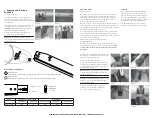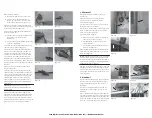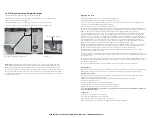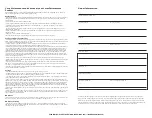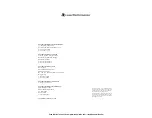
A. Removing your Stratos Keel hull and trolley from the road base.
1.
Warning:
When removing the Stratos’ keel and launching trolley from the road base, it is highly
recommended to leave the road base hitched to your vehicle or to chock the front of the road base
wheels.
Th
is is to prevent the road base shooting forwards as the boat and trolley are pushed aft.
Failure to do this could lead to injury or damage.
2.
If a winch is fi tted to your trailer base, release the ratchet. One person can control the aft movement
of the boat and trolley on the winch handle, while the others push and guide the boat and trolley
off the road base.
Warning:
Th
e Stratos’ keel is a substantial product that requires care to avoid injury when
maneuvering on and off the water.
To avoid hitting solid objects with the keel do not run aground at speed.
B. Launching your Stratos Keel.
Select a launching area where there is deep enough water to fl oat the Stratos Keel off the trolley. Care
must be taken to ensure that the keel passes through the gap in the trolley bunk.
C. Lowering the Stratos Keel
Warning:
•
Th
e keel weighs approximately 120 kgs. and may damage the boat if dropped in an uncontroled
manner. Do not allow children or anyone of inadequate strength or experience to operate the keel
mechanism without close supervision or assistance.
• Ensure that the operators and other crewmembers feet and fi ngers are well clear of the keel and
operating mechanism when lowering and hoisting to avoid injury.
• Suitable sailing shoes should always be worn when sailing to avoid injury to your feet.
• Ensure that the hoist line is clear and free and that all other line are well clear of the hoisting
mechanism. (Stray line jammed in the keel box or hoist mechanism could be very diffi
cult
to
remove).
• Ensure that the keel box and keel are free from sand, pebbles and other debris.
13. Using Your Stratos “Keel”
1.
Attach the hoist retaining line hook to
the hoist frame. (fi gure 59)
2.
While holding the hoist line securely,
pull the line upwards and forward. Th
is
will uncleat the line. Always maintain
controled tension on the line while it is
uncleated, anticipating that the full
weight of the keel will be controled by
the hoist line. Never allow the keel to
drop uncontrollably. (fi gure 60)
3.
Gently lower the keel in accordance with
the water depth. (fi gure 61)
4.
When the keel is lowered. Secure the
retaining line/strap over the top of the keel
and cleat in position. In the unlikely event
of capsize, this will prevent the keel from
falling back into the boat. (fi gure 62)
5.
Th
e hoisting frame can now be lowered
forward onto the cockpit fl oor. (fi gure 62)
Note:
Th
e sails are rigged and hoisted as per the
standard Stratos Keel rigging instructions.
fi gure 60
fi gure 62
fi gure 59
fi gure 61
D.Hoisting the Stratos keel
1.
Anticipate arriving in shallow water and always allow plenty of time to hoist the keel.
2.
Release the keel-retaining strap/line.
3.
Raise the hoist frame above the keel and ensure that it is fully upright.
4. Attach the hoist retaining line hook to the hoist frame.
5.
Ensure that the keel and hoist system is free from obstruction, stray lines and debris.
Also, ensure that the gennaker sheets are secured so they don’t get wrapped around the keel.
6.
While holding the hoist line fi rmly, progressively hoist the keel fully up and secure the rope
in the cleat. For added security the rope end can be tied off onto the hoist frame.
E. Recovering Your Stratos “Keel.”
1.
While one crewmember holds the bow of the boat, another can lower the sail and then get
the launching trolley.
2.
Position the trolley in deep enough water so that your Stratos Keel can be fl oated back
onto the trolley.
3.
Carefully guide the boat onto the trolley so that the keel passes cleanly through the
gap in the trolley bunk.
4.
Secure the bow to the trolley and pull the boat out of the water.
5.
After derigging the boat, the boat and trolley can be pulled or winched onto the road base. It is
essential the road base wheels are chocked aft or the road base must be hitched to your vehicle.
6.
Before trailing, lower the keel so that the weight of the keel is supported by the keel platform
on the trolley.
Warning:
• We recommend that a trailer and road base supplied by LaserPerformance is used,
so that the keel and hull are correctly supported to avoid damage.
• It is the owner’s responsibility to maintain his trailer. Th
e height of the trolley bunk should
be adjusted and checked regularly to ensure that it is supporting the hull with the keel resting
on the support platform. Also, the wheel bearings should be serviced regularly.
Th
e following is a rough guide to the position of the trolley bunk.
Dimension A = 195 mm
from the top of the launching trolley axle to the underside of the
trolley bunk measured by the inner face of the inner leg.
Dimension B = 280 mm
from the top of the launching trolley/dolly axle to the turn of
the chine measured from the underside of the trolley/dolly bunk.
b
a
Fogh Marine | 416 251-0384 | www.foghmarine.com | [email protected]



